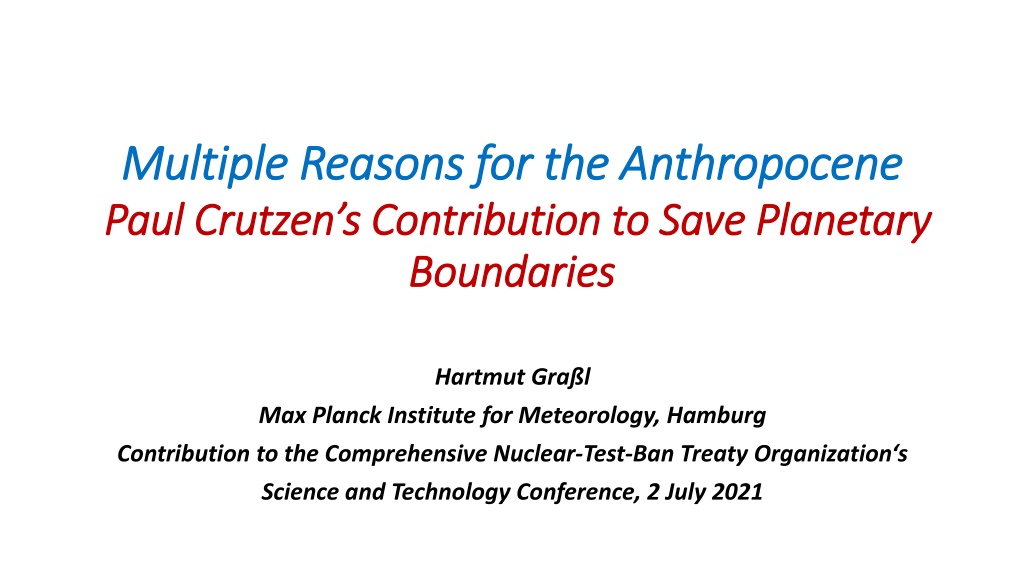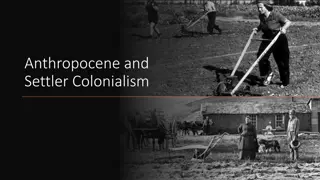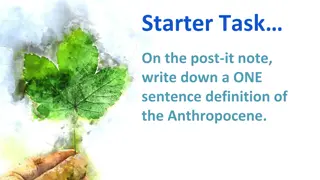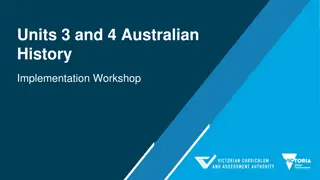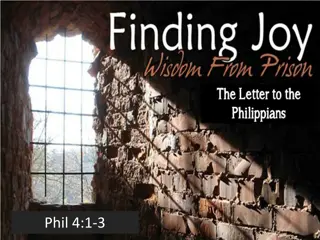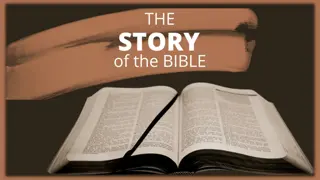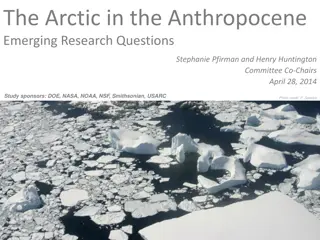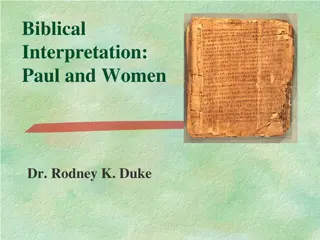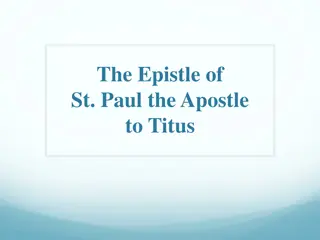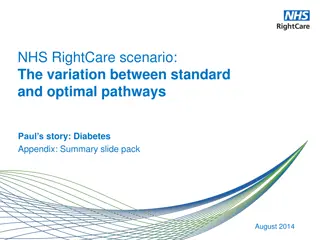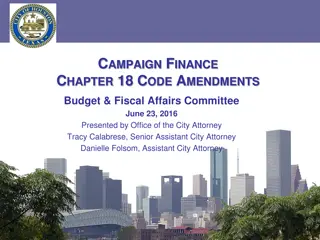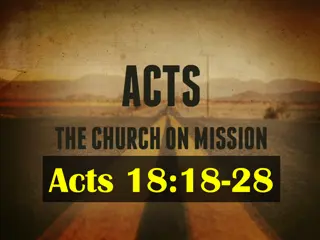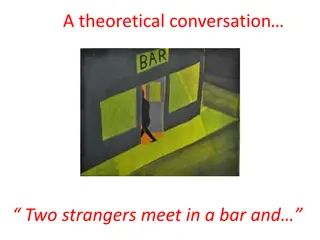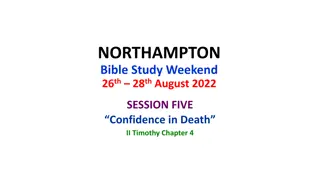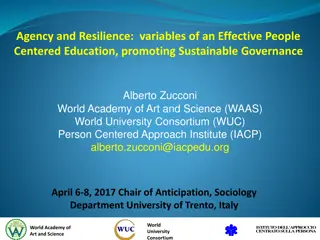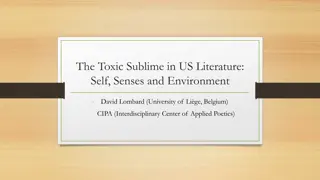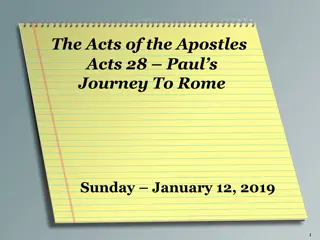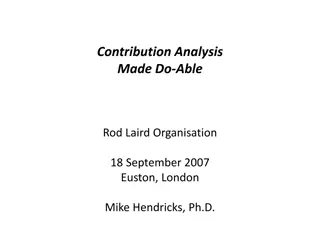Understanding the Anthropocene: A look into Paul Crutzen's Contribution
Paul Crutzen's work highlights the significant impact of human activities on the environment, leading to the proposed term Anthropocene to define this era. His research emphasizes the need to address the overuse of resources and the threat it poses to global boundaries. The current situation shows a mix of progress and challenges, with research empowering us to tackle both the benefits and dangers of scientific advancements.
Download Presentation

Please find below an Image/Link to download the presentation.
The content on the website is provided AS IS for your information and personal use only. It may not be sold, licensed, or shared on other websites without obtaining consent from the author. Download presentation by click this link. If you encounter any issues during the download, it is possible that the publisher has removed the file from their server.
E N D
Presentation Transcript
Multiple Reasons for the Anthropocene Multiple Reasons for the Anthropocene Paul Paul Crutzen s Crutzen s Contribution to Save Planetary Contribution to Save Planetary Boundaries Boundaries Hartmut Gra l Max Planck Institute for Meteorology, Hamburg Contribution to the Comprehensive Nuclear-Test-Ban Treaty Organization s Science and Technology Conference, 2 July 2021
Paul J. Crutzen (2002): For the past three centuries, the effects of humans on the global environment have escalated. Because of emissions of carbon dioxide, global climate depart significantly from for many millennia appropriate to assign the term Anthropocene to the present, in many ways human-dominated, geological epoch, supplementing the Holocene the warm period millennia. The Anthropocene could be said to have started in the latter part of the eighteenth century, when analyses of air trapped in polar ice showed the beginning of growing global concentrations of carbon methane. This date also happens to coincide with James Watt s design of the steam engine in 1784. 1933 - 2021 these anthropogenic may natural behaviour to come. It seems of the past 10 12 dioxide and
Present Situation The research results have made scientists more and more powerful. Based on technological and societal progress a higher percentage of humans than ever before enjoys a decent life and lives on average much longer than all earlier generations. But the misuse of research results also has led to weapons of mass destruction, whose threat may have reduced, however, the number of conventional wars. Research on the functioning of the Earth system, predominantly only in rich democratic countries, has on the other side unveiled the longterm global threats caused by the mere overuse of resources. This overuse has driven us outside several save boundaries, into which we have to come back. Paul Joseph Crutzen, a Dutchman and a civil engineer by training, is among those having laid the foundation for the understanding of the transgression into the dangerous zone and the way back into a safe one.
Contents The term Anthropocene When did it start? The stratospheric ozone layer The ozone hole The Montreal Protocol Nitrous oxide increase continues to weaken the ozone layer Aerosol particles in the stratosphere: Geo-engineering and Nuclear Winter The extreme sensitivity of sea level to temperature changes
Holocene becomes Anthropocene Two publications by Paul Crutzen establish the term worldwide 1)The IGBP Newsletter 38 of May 2000: The Anthropocene by Paul J. Crutzen and Eugene F. Stoermer Definition: Considering these and many other major and still growing impacts of human activities on earth and atmosphere, and at all, including global, scales, it seems to us more than appropriate to emphasize the central role of mankind in geology and ecology by proposing to use the term anthropocene for the current geological epoch. 2) The Article in Nature in 2002
ANTHROPOCENE When did we become dominant, overriding natural forces to change the planet Earth? The Trinity test of 6 July 1945 in New Mexico, USA? The steam engine invented by James Watt in 1784? Or even much earlier?
From the press release of the Nobel Prize Committee of the Swedish Academy of Sciences in 1995 The scientist to take the next fundamental step towards a deeper understanding of the chemistry of the ozone layer was Paul Crutzen. In 1970 he showed that the nitrogen oxides NO and NO2 react catalytically (without themselves being consumed) with ozone, thus accelerating the rate of reduction of the ozone content. NO + O3 -> NO2 + O2 NO2+O -> NO+O2 O3+uv-light -> O2+O ______________________ Net result: 2O3 -> 3O2
Nobel Committee press release in 1995 continues: These nitrogen oxides are formed in the atmosphere through the decay of the chemically stable nitrous oxide N O, which originates from microbiological transformations at the ground. The connection demonstrated by Crutzen between microorganisms in the soil and the thickness of the ozone layer is one of the motives for the recent rapid development of research on global biogeochemical cycles. Hence, the global increase in nitrogen fertilization increases the attack on the stratospheric ozone layer
Nitrogen Oxides Dominate the Ozone Destruction in the Stratosphere Source: M ller, Ambio, 2020
This understanding has allowed - only 15 years before the detection of the anthropogenic ozone hole - to explain the comparably low ozone concentration in the stratosphere under natural conditions. But Paul Crutzen s finding was also one of the keys to understand the ozone hole .
Do we have international law bringing us back into the safe zone? Global Governance Weltinnenpolitik YES: The success story: Montreal Protocol 1987 Probably: A goal set: Paris Agreement 2016
The Montreal Protocol on Substances that Deplete the Ozone Layer is an international treaty to protect the ozone layer by phasing out the production of numerous substances that are responsible for ozone depletion. Open for signature on 16 September 1987, pursuant to the 1985 Vienna Convention for the Protection of the Ozone Layer, the Montreal Protocol entered into force on 1 January 1989, and has since undergone nine revisions, in 1990 (London), 1991 (Nairobi), 1992 (Copenhagen), 1993 (Bangkok), 1995 (Vienna), 1997 (Montreal), 1998 (Australia), 1999 (Beijing) and 2016 (Kigali). The maximum size of the Ozone Hole September 2006
The impact of the rise in atmospheric nitrous oxide on stratospheric ozone Rolf M ller, Ambio, 50, 35 39 (2021) More than fourty years ago Ambio published a paper that raised concerns about the increased use of fixed nitrogen as fertilizer in that the resulting increase in nitrous oxide (N O) emissions to the atmosphere could result in a significant reduction of the Earth s ozone shield (Crutzen and Ehhalt, 1977). It presented another case of human activities at the Earth s surface impacting on the stratospheric ozone layer. Today, it is known that atmospheric N O, which is present in the atmosphere in 2020 at a mixing ratio of 332.8 ppb, is not only important for stratospheric ozone but also constitutes the third most important long-lived greenhouse gas (after CO and CH ). N O is essentially inert in the troposphere and has no significant sinks at the surface of the Earth. However, when transported to the stratosphere it will be broken down mainly via photolysis at short wavelengths (below 200 nm)
Aerosol Particles in the Stratosphere Nuclear Winter and Global Cooling by Sulphate Particles The key for understanding the potential nuclear winter phenomenon or the global cooling by sulfate particles is the residence time of sub-micron aerosol particles in the stratosphere To both research topics Paul Crutzen contributed the first or stimulating papers, 1982 for Nuclear Winter, 2008 for Geo-engineering by sulfate particles The large uncertainties remaining, however, need much further research.
Paul Crutzen has also stimulated a global research activity in the Geo- engineering Arena by his article Crutzen, P. J. (2006): Albedo Enhancement by Stratospheric Sulfur Injections: A Contribution to resolve a Policy Dilemma? Climatic Change 77(3), S. 211 220. He had asked me beforehand whether he should submit and I said yes. Now the result of many research papers and technological progress in the renewable energy sources arena is: Emission reduction is the only way without new risks
NO release from agro-biofuel production negates global warming reduction by replacing fossil fuels P. J. Crutzen, A. R. Mosier, K. A. Smith, and W. Winiwarter Published in Atmos. Chem. Phys. Discuss.: 1 August 2007 Revised: 20 December 2007 Accepted: 20 December 2007 Published: 29 January 2008 Paul Crutzen did not only dampen the biomass use hype for climate protection but also pointed at the same time to the growing threat to stratospheric ozone.
Aside from as a Nobel laureate, how do you want to be remembered? As the person, who significantly increased knowledge about the processes that determine the distribution of ozone in the atmosphere. And as the scientist Anthropocene : A new geologic epoch dominated by human activities. And as one of the scientists who drew attention to the potentially devastating climatic consequences of a nuclear war, the so-called nuclear winter . More people consequences of mass starvation and disease than would be killed by the nuclear bombs. who coined the term would die of the indirect Nature 2010
